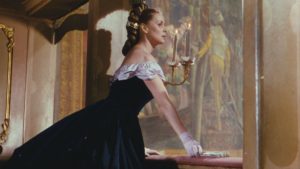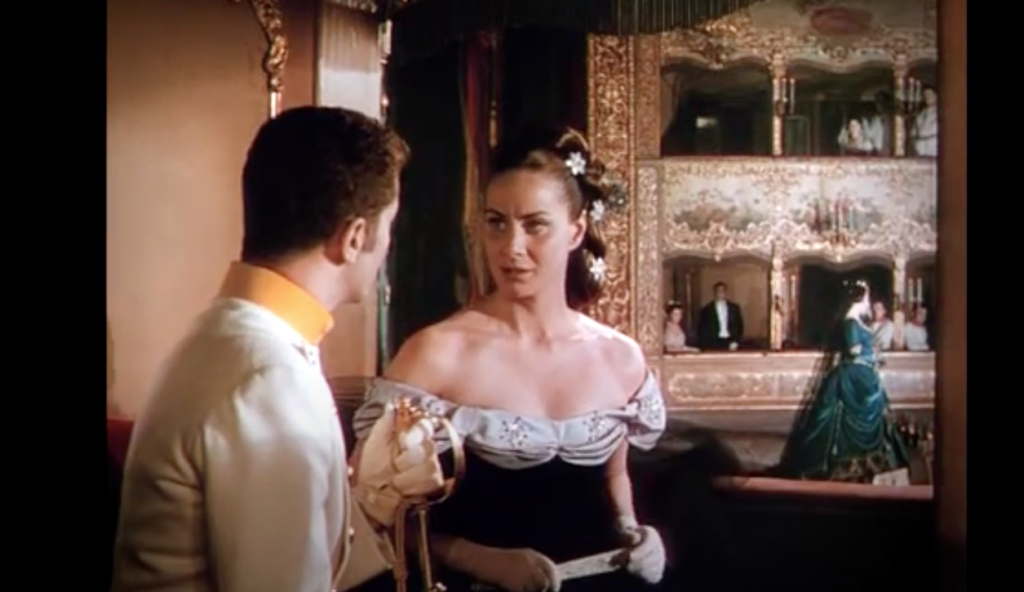
Opera Meets Film: Luchino Visconti’s ‘Senso’ As a Cinematic Opera
By David Salazar“Opera Meets Film” is a feature dedicated to exploring the way that opera has been employed in cinema. We will select a section or a film in its entirety, highlighting the impact that utilizing the operatic form or sections from an opera can alter our perception of a film that we are viewing. This week’s installment features Luchino Visconti’s “Senso.”
It can be argued that no opera sequence in a film is more iconic than the opening sequence of Visconti’s “Senso.”
Just watch it.
The entire scene is a film unto itself in which Visconti tells not only the story taking place on the operatic stage, but interjects it directly into the historic context.
The film thrusts us into La Fenice in 1866, the cusp of the Italian fight for Independence from Austrian rule. We are given this information over a title card playing right after the opening credits, which take place over the love duet between Manrico and Leonora from “Il Trovatore.”
The choice to start with the duet is not insignificant. At the core of Senso is a love story between an aristocratic woman and a soldier; Manrico and Leonora very much occupy those social places in Verdi’s famed opera. The duet, like the romance in the opera, is brief and fleeting; it hints that a similar fate for the central romance between Mahler and Livia Serperi.
Then we launch right into the transition to “Di Quella Pira,” the camera very much remaining on stage. When Manrico rushes to the front of the stage to burst into his iconic aria, Visconti camera pans out into the audience for the first time. The synchronization of Manrico’s forward movement, sword in hand, with the pan from the camera that reveals the sea of Austrian soldiers almost makes you feel like he is rushing right at them in a declaration of war.
Stage and reality merge at this moment as Visconti then cuts to the stalls where behind it all, we see audience members passing out red, green, and white papers that they will toss on stage in just a few moments.
This literal merging of the real with the theatrical culminates in the sequence’s final moments when the papers go flying like confetti and the show is brought to an abrupt interruption with Manrico’s final call to arms to free his mother from the oppressive Conte di Luna (the metaphor of liberating the motherland cannot be overlooked).
From here on out, the film will chart a course in which this fight becomes the central narrative force (even if it is kept in the background).
We could stop here with this perfect fusion of music and cinematic language, but Visconti doesn’t let us.
Moments later, the central plot kicks into gear and Livia heads over to meet Mahler to stop a duel (more on this later). As she sits in the box with his, the ensuing scene from “Il Trovatore” kicks off. A brief recitative leads us to Leonora’s “Amor sull’ali rosee” while Serpieri and Mahler converse.
As the conversation unfolds in the foreground, we see the soprano walk to the front of the stage, appearing prominently in the background behind the two doomed lovers.

In the documentary “Viva Verdi: Visconti and Opera,” the commentators note how this idea of a singer walking all the way to the front of the stage was inspired by Maria Callas doing the same thing during a performance of “Il Trovatore;” Visconti was in attendance and when he made “Senso,” he could not pass up the opportunity.
But more than an ode to Maria Callas, this framing is yet another example of Visconti merging theater and reality in this film, dropping further hints that he sees this film in operatic terms.
The soprano and Livia reflect one another in the image. While the soprano is pleading her case to the audience as she stares down the death of her beloved Manrico, Livia is having an audience with Mahler to save the life of her cousin Roberto (a major rebel crucial to the independence war effort) who has previously challenged Mahler to a duel; right after Leonora’s big aria, she too will plead for Manrico’s life.
From a plot perspective, the two women actually experience inverse circumstances, yet both suffer the same fate. Leonora enjoys a tense romance with Manrico, who is constantly running away from one woman he loves (Leonora) to the other (his mother), his loyalty divided as he grapples with his identity. Meanwhile, she is constantly warding off the advances of the Conte di Luna. At the end of the opera, Leonora agrees to give herself to the Conte in return for Manrico’s life. But in doing so, she also poisons herself to ensure that she never betrays the man she loves. In the end, both of them end up dead.
Meanwhile, Livia is pushed and pulled back and forth by her love for Mahler, a man who follows her around, seduces her, then runs off on her, and then shows up in her window, only to run off on her again when she gives him the resistance’s money (an act of betrayal to her motherland that unfortunately never gets further development) to save him from going to battle. Where Manrico is grappling with his identity and loyalties, Mahler is presented as more mysterious. He’s a romantic hero at the start, but we slowly see a manipulative side to him until he is revealed as a self-serving coward by the end of the film.
Unlike Leonora, who sacrifices herself to save Manrico (who, by the way, insults her when he thinks that she has betrayed him), Livia, after being humiliated by Mahler in front of another woman, actually betrays him to his officers, leading to him being executed. It can’t be lost on anyone that the film comes to an abrupt end after the execution of Mahler; “Il Trovatore” has often been criticized for how quickly it wraps everything up with Manrico’s speedy execution.
We aren’t made privy to Livia’s fate, though the last time we see her, she is walking down a dark, empty street.
Structurally the film plays very much like an opera. The scene in the opera house feels like a prelude (the plot centers around a potential duel, which is actually the subtitle of the first Act of “Il Trovatore”) with the ensuing act, which takes place in Venice, centering on the start of the main romance between Mahler and Livia. Then the story shifts to a second act out in the quiet countryside in the Count Serpieri’s palace before eventually shifting to grimy and decadent streets of Verona for its climactic finale. These acts not only represent shifts in space, but also time, connected mainly by Livia’s voiceovers (which have been compared to aria-like passages) as she recounts and reacts to events that are not shown onscreen.
In addition to the lush visual splendor of the larger-than-life sets and similarly accentuated acting styles that emphasize the operatic qualities of the film, “Senso” includes lengthy scenes between the lovers that have the feeling of expansive love duets that become the central focus of each Act. There is a lot of other interstitial narratives (or “recitative”) going on around the characters that emphasize the shifting times, but all of this seems to stop and recede into the background when the romance takes center stage. The action literally stops so that Visconti can focus on the feelings of these Livia and Mahler.
One final comment must be made about Verdi. The famed composer was, in many ways, the poster boy for Risorgimento and he would eventually become a Senator in later life. Few composers were as overt about their politics in their operas as Verdi was during much of his career. But in doing so, Verdi, more than any other Italian composer in the history of opera, managed to balance the challenges of political and personal strife in nearly all of his operas. His melodramas give his characters and their feelings the main focus, but without ever disengaging from the social and political forces moving around them.
Visconti manages a similar balancing act in “Senso,” one that he would further in other major films such as “Il Gattopardo” or “The Damned.” But few are as operatically pure as “Senso.”
Categories
Opera Meets Film

